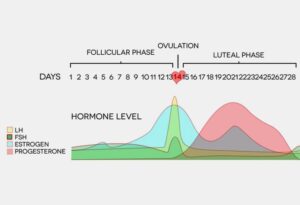
Tiffany is very frustrated by not being able to get pregnant. After charting her cycles for several months, she realized that the time between ovulation and the start of her menstrual cycle was abnormally short. She found out this situation is called a luteal phase defect. She did not like thinking of herself as having a “defect”, and set out to learn more.
What If My Luteal Phase is Short?
The luteal phase of your menstrual cycle is from ovulation to menstruation. This phase should last 12-16 days. If it is shorter than this, it is known as a luteal phase defect (LPD). Having a short luteal phase (less than 12 days), can affect your fertility.
To better understand what this means, you need to know what a normal menstrual cycle is like.
Normal Menstrual cycle
- Follicular Phase
- Ovulation
- Luteal Phase
A normal menstrual cycle lasts from 26-35 days.
The follicular phase begins on the first day of the menstrual cycle, the day you begin bleeding. This phase lasts from 12-21 days. Rising levels of follicle stimulating hormone (FSH) and luteinizing hormone (LH) stimulate the growth of several ovarian follicles, and one becomes dominant. During the follicular phase, estrogen is the main hormone.
At ovulation, LH levels rise (LH surge), causing the mature follicle to release the egg. Just before and during ovulation is when you are fertile and can conceive.
The third phase is the luteal phase. This phase lasts 12-16 days, usually 14. The follicle becomes the corpus luteum, and progesterone becomes the dominant hormone. This higher level of progesterone is what raises your basal body temperature. The uterine lining changes in preparation for the potential implantation of an embryo if fertilization has occured.
If fertilization and implantation do occur, the corpus luteum continues to produce progesterone and estrogen. This is necessary to maintain pregnancy.
There are 4 ways your normal menstrual cycle can be disrupted and cause a luteal phase defect. The result can be infertility or miscarriage.
- Inadequate follicle development
- Premature failure of the corpus luteum
- Poor uterine lining
- High estrogen
Poor follicle development begins in the follicular phase of your cycle. You may not produce enough FSH, or your ovaries do not respond to it. The ovarian follicle does not develop adequately, and then cannot produce enough progesterone. This causes the uterine lining to not develop enough to be prepared for the implantation of a fertilized embryo.
Premature failure of the corpus luteum may occur even when the follicle was adequate. The corpus luteum does not last, and thus not enough progesterone is produced. This leads to earlier onset of menstruation, and a shorter luteal phase.
Failure of the uterine lining to develop normally can occur even in the presence of a normal follicle and corpus luteum. The uterine lining does not respond to normal levels of progesterone. The lining is not adequate for implantation of the embryo.
High estrogen levels can cause a relative deficiency of progesterone, even though levels of progesterone may actually be normal.
What can you do to know if you have a short luteal phase?
- Chart your cycle
- Calculate your luteal phase
Chart your cycle. The best way to understand your menstrual cycle is to create your very own ovulation calendar. See the article: “What 10 Things Should I Put on My Ovulation Calendar“. This calendar is the summary of all things related to your menstrual cycle. You want to know what a normal cycle is like, and then to know your own cycles and how they compare to that.
Your luteal phase is simply the number of days between when you ovulate and when you begin bleeding. The trick is to know when you ovulate. This is something you want to know, as the days just before and during ovulation are when you can get pregnant. See the article: “What are the Signs of Ovulation“.
To Your Vibrant Health!
Veronica Tilden, DO
